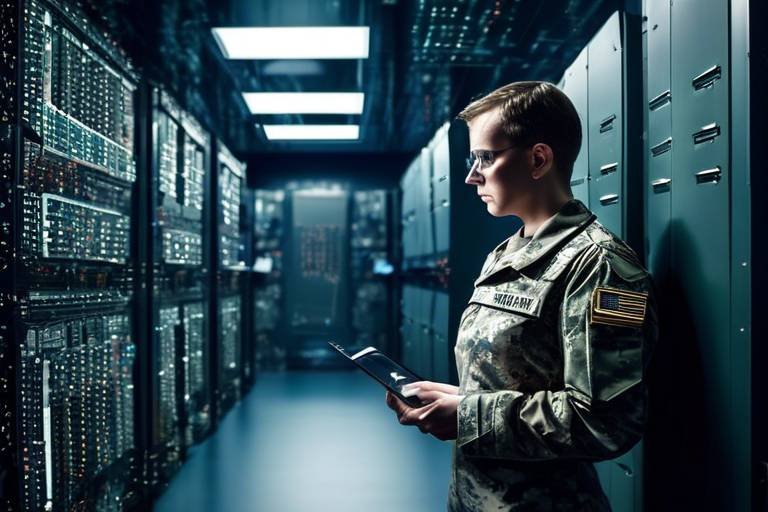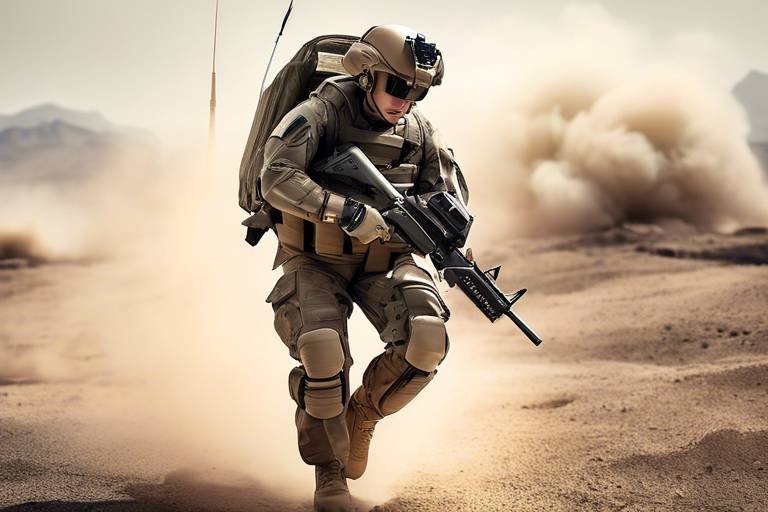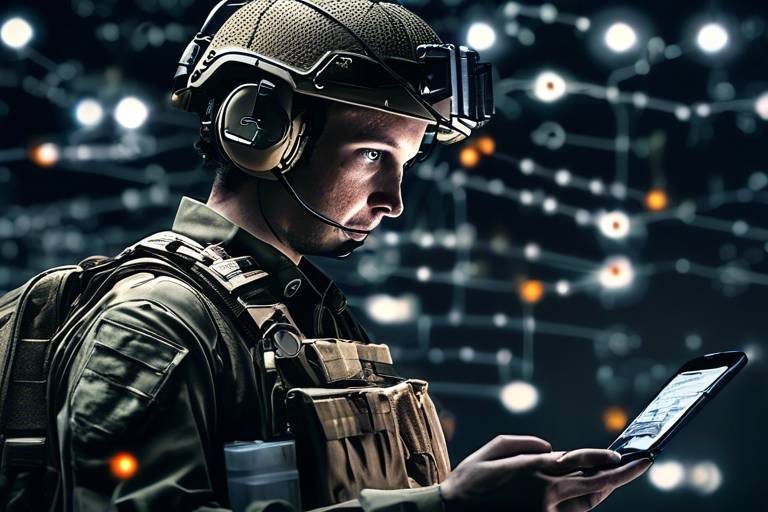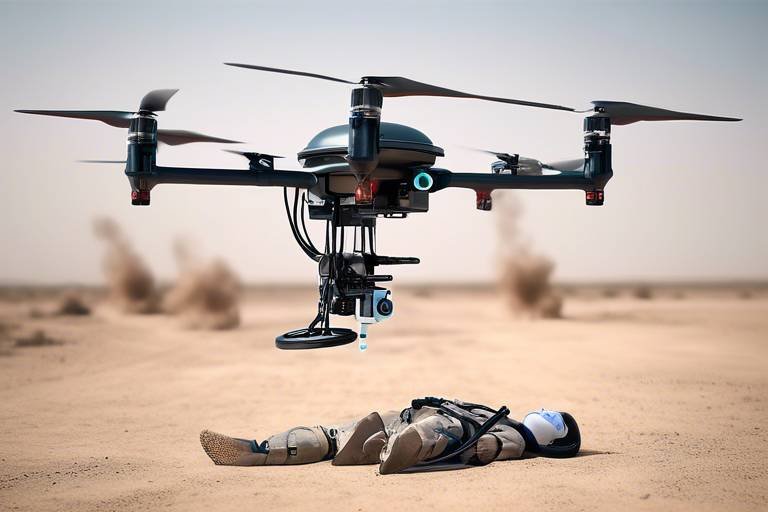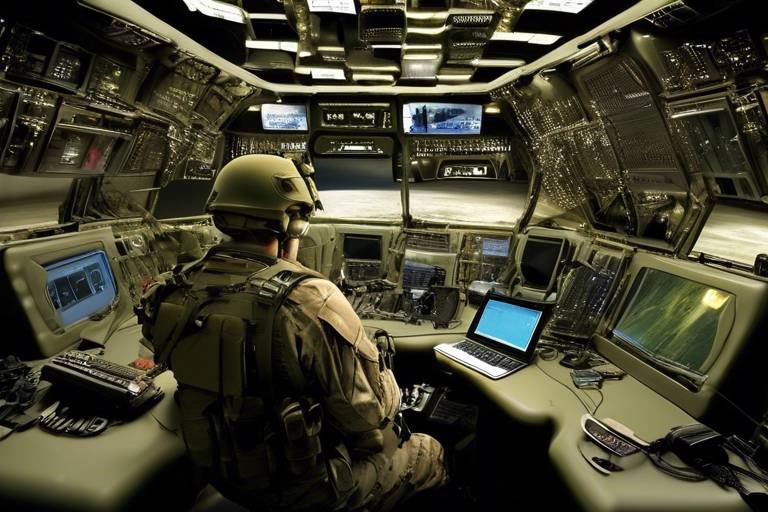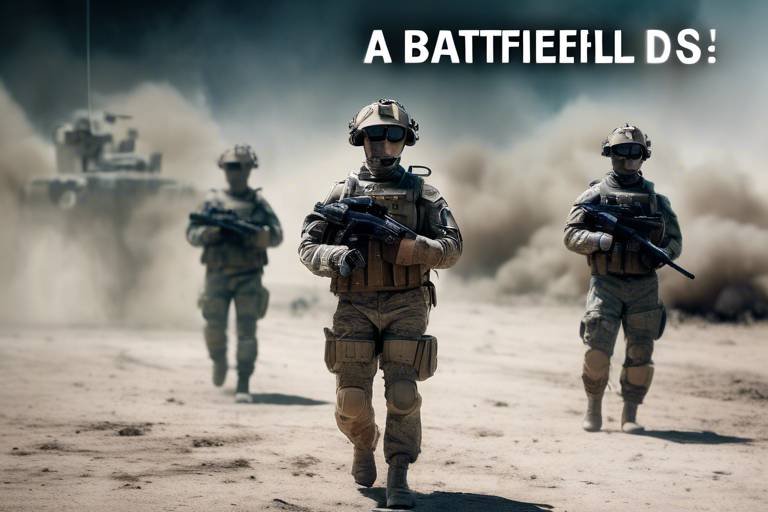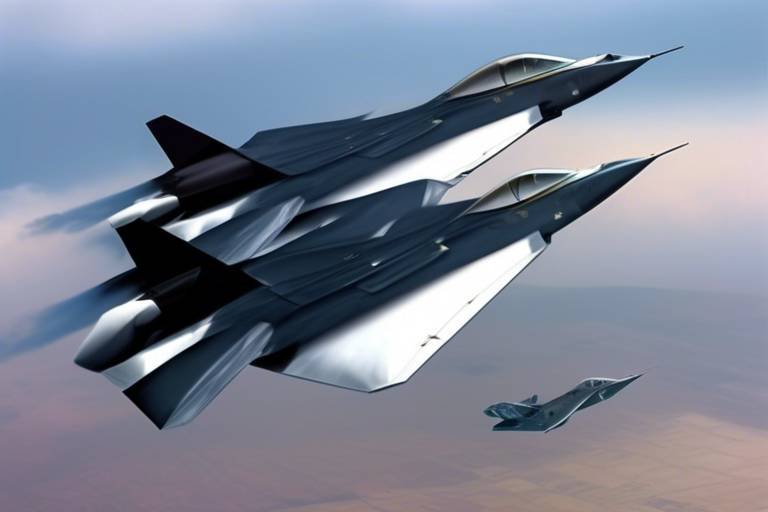How AI is Powering Modern Warfare Simulations
The landscape of modern warfare is evolving at an unprecedented pace, and at the forefront of this transformation is artificial intelligence (AI). As military forces worldwide strive to adapt to new challenges and technologies, AI is becoming an essential tool in enhancing warfare simulations. These simulations are not just about training; they are a comprehensive approach to strategy development, operational efficiency, and decision-making in real-time scenarios. Imagine a soldier stepping into a virtual battlefield where every move is analyzed, every decision is critiqued, and every outcome is a learning opportunity. This is the reality that AI is creating, and it's revolutionizing how military personnel prepare for the complexities of modern combat.
One of the most significant advantages of AI in warfare simulations is its ability to create immersive training environments. These AI-driven simulations provide realistic scenarios that mimic real-world conditions, allowing military personnel to hone their skills in a controlled yet dynamic setting. The beauty of these simulations lies in their adaptability; they can evolve based on the performance and learning curves of individual soldiers. This personalized approach ensures that each soldier is not just a participant but an active learner, gaining insights that traditional training methods often overlook.
Moreover, the integration of AI allows for real-time data analysis during training exercises. Think about it: commanders can now access vast amounts of data instantaneously, enabling them to make informed decisions on the fly. This capability not only improves response times but also enhances operational effectiveness in both training and actual combat scenarios. Imagine a commander in the heat of battle, equipped with AI tools that analyze the situation and provide actionable insights—this is not science fiction; it's the new reality of warfare.
AI-driven training simulations are redefining how military personnel prepare for the battlefield. They offer a level of detail and realism that traditional methods simply cannot match. By utilizing advanced algorithms, these simulations can adapt to the actions of participants, creating unique challenges that require quick thinking and strategic planning. This adaptability means that no two training sessions are alike, keeping soldiers engaged and constantly learning.
Furthermore, AI’s role in predictive analytics cannot be overstated. With the ability to forecast potential battlefield scenarios, military strategists can prepare for various outcomes. This foresight allows for the optimization of tactics, ultimately enhancing mission success rates. In a world where the only constant is change, being able to predict and prepare for different scenarios is invaluable.
Predictive analytics powered by AI can forecast potential battlefield scenarios, allowing military strategists to prepare for various outcomes and optimize their tactics, ultimately enhancing mission success rates. This capability is particularly critical in an era where threats can emerge from unexpected directions. By leveraging historical data and current trends, military planners can craft strategies that are not only reactive but also proactive.
AI tools facilitate detailed scenario planning and risk assessment, enabling military planners to evaluate potential threats and devise comprehensive strategies that minimize risks in unpredictable environments. The ability to simulate various scenarios helps in understanding the implications of different decisions, ultimately leading to more informed choices on the battlefield.
AI simulations can create training scenarios based on historical data and emerging trends, preparing soldiers for unforeseen circumstances and ensuring they are equipped to handle diverse challenges on the battlefield. This level of preparedness is crucial as warfare becomes increasingly complex and unpredictable.
AI fosters collaboration among different military branches and allied forces by streamlining communication and information sharing, ultimately improving interoperability and joint operational capabilities during complex missions. In a world where military operations often involve multiple nations and branches, effective communication is key to success.
By leveraging AI algorithms, military forces can enhance their tactical planning processes, allowing for more efficient resource allocation and mission execution through data-driven insights and strategies. This capability is essential in ensuring that military operations are not just effective but also efficient.
AI systems analyze resource availability and deployment options, enabling military leaders to optimize logistics and supply chains, ensuring that troops have the necessary support during critical operations. The ability to efficiently manage resources can be the difference between success and failure in combat.
AI enables the development of adaptive strategies that can evolve in real-time based on battlefield dynamics, ensuring that military forces remain agile and responsive to changing conditions and enemy actions. This adaptability is crucial in modern warfare, where the ability to pivot quickly can lead to mission success.
- How is AI used in military training?
AI is used to create immersive training simulations that adapt to individual performance, providing realistic scenarios for soldiers to practice their skills. - What are the benefits of AI in real-time decision-making?
AI allows for the quick analysis of vast data sets, enabling commanders to make informed decisions that improve response times and operational effectiveness. - Can AI predict battlefield scenarios?
Yes, AI can analyze historical data and current trends to forecast potential scenarios, helping military strategists prepare for various outcomes. - How does AI enhance collaboration among military forces?
AI streamlines communication and information sharing, improving interoperability and joint operational capabilities during complex missions.

The Role of AI in Training Simulations
In today's fast-paced world, artificial intelligence (AI) is revolutionizing the way military personnel are trained. Gone are the days of static, one-size-fits-all training programs. Now, with the integration of AI-driven training simulations, soldiers can engage in realistic environments that adapt to their individual performance and learning styles. Imagine stepping into a virtual battlefield where every decision you make influences the outcome of the scenario. This level of immersion not only enhances decision-making skills but also significantly boosts tactical awareness.
These AI simulations are designed to create scenarios that mimic real-world challenges, allowing trainees to experience a range of situations—from the mundane to the extreme. For instance, a soldier might find themselves in a simulated urban combat zone, where they must navigate through complex environments, make split-second decisions, and respond to unexpected threats. The beauty of AI lies in its ability to learn from each trainee's actions, adjusting the difficulty and complexity of the scenarios based on their performance. This personalized approach ensures that no two training sessions are alike, keeping soldiers engaged and challenged.
Furthermore, the data collected during these training sessions is invaluable. AI systems analyze the decisions made by trainees, identifying patterns and areas for improvement. This feedback loop allows instructors to tailor future training sessions to address specific weaknesses, ensuring that each soldier is continuously evolving in their skill set. For example, if a trainee consistently struggles with communication in high-pressure situations, the AI can create scenarios that specifically focus on improving this aspect.
Another fascinating aspect of AI in training simulations is the ability to incorporate historical data and real-time information. By analyzing past conflicts and current battlefield dynamics, AI can simulate environments that are not only realistic but also relevant to today's military landscape. This means that soldiers are not just training for generic scenarios; they are preparing for the specific challenges they may face in actual combat.
Moreover, the use of AI in training simulations fosters collaboration among different military branches. For instance, joint exercises can be conducted where soldiers from various units interact within the same simulation, enhancing their ability to work together in real-world missions. This collaboration is crucial as modern warfare often requires seamless integration between air, land, and sea forces.
In summary, AI-driven training simulations are transforming military training by providing immersive, personalized experiences that enhance decision-making, tactical awareness, and collaboration. As technology continues to evolve, the potential for even more sophisticated training environments is limitless, paving the way for a new era of military preparedness.
- How does AI improve military training simulations? AI enhances training by creating adaptive scenarios that respond to individual performance, ensuring realistic and personalized learning experiences.
- Can AI simulations prepare soldiers for real battlefield conditions? Yes, AI simulations are designed to mimic real-world challenges, incorporating historical data and current trends to create relevant training environments.
- What role does data analysis play in AI training simulations? Data analysis allows for continuous improvement by identifying patterns in trainee performance, enabling instructors to tailor future training sessions.
- How does AI foster collaboration among military branches? AI simulations can facilitate joint exercises, allowing different military units to interact and improve their ability to work together in complex missions.

Real-Time Data Analysis and Decision Making
In the fast-paced world of modern warfare, the ability to make quick and informed decisions can mean the difference between victory and defeat. This is where real-time data analysis powered by artificial intelligence comes into play. Imagine being in the heat of battle, surrounded by chaos, and having the capability to analyze vast amounts of data in mere seconds. That’s not just a dream; it’s the reality that AI brings to military operations today.
AI systems can process information from multiple sources—satellite imagery, drone surveillance, and even social media feeds—integrating them into a cohesive understanding of the battlefield. This means that commanders can receive a comprehensive overview of the situation without sifting through mountains of data manually. For instance, during a training exercise, AI can analyze the movements of troops, predict enemy actions, and suggest optimal responses based on real-time conditions. It’s like having a tactical advisor that never sleeps!
Moreover, the incorporation of machine learning algorithms allows these systems to learn from past engagements. They can identify patterns and trends that human analysts might overlook, providing insights that enhance operational effectiveness. For example, if a particular strategy has proven successful in previous exercises, the AI can recommend its application in current scenarios, adjusting for any changes in the environment or enemy tactics.
One of the most significant advantages of real-time data analysis is its impact on response times. In a combat situation, every second counts. AI systems can deliver actionable intelligence almost instantaneously, allowing military leaders to make decisions that can alter the course of an operation. This agility is crucial when faced with unpredictable enemy movements or rapidly changing battlefield conditions.
Furthermore, the use of AI in decision-making goes beyond just immediate tactical advantages. It also contributes to longer-term strategic planning. By analyzing data from multiple engagements, AI can help military planners identify potential weaknesses in their strategies and recommend adjustments that can lead to improved outcomes in future operations.
To illustrate the power of AI in real-time decision-making, consider the following table that outlines key benefits:
| Benefit | Description |
|---|---|
| Speed | AI systems provide instant analysis, reducing the time needed for decision-making. |
| Accuracy | Machine learning algorithms enhance the precision of predictions and recommendations. |
| Adaptability | AI can adjust strategies in real-time based on evolving battlefield conditions. |
| Comprehensive Analysis | Integration of data from various sources offers a complete picture of the situation. |
In conclusion, the integration of AI into real-time data analysis and decision-making processes is revolutionizing military operations. It empowers commanders with the tools they need to act swiftly and effectively in complex environments, ultimately enhancing both training exercises and actual combat scenarios. As technology continues to advance, we can only expect these systems to become more sophisticated, further improving the capabilities of military forces around the globe.
- How does AI improve decision-making in military operations? AI enhances decision-making by providing real-time analysis of data, allowing commanders to make informed choices quickly.
- What types of data can AI analyze in a battlefield scenario? AI can analyze data from satellite imagery, drone feeds, troop movements, and even social media, integrating this information for a comprehensive understanding of the battlefield.
- Can AI systems adapt to changing battlefield conditions? Yes, AI systems are designed to learn and adapt in real-time, adjusting strategies based on evolving conditions and enemy actions.
- What are the long-term benefits of using AI in military decision-making? Long-term benefits include improved strategic planning, enhanced operational effectiveness, and the ability to identify and mitigate potential weaknesses in tactics.

Predictive Analytics in Warfare
In today's rapidly evolving battlefield, predictive analytics has emerged as a game-changer for military strategists and decision-makers. Imagine having the ability to foresee potential threats and opportunities before they even materialize. This is precisely what AI-powered predictive analytics offers. By analyzing historical data, troop movements, weather patterns, and even social media trends, military leaders can anticipate various battlefield scenarios and prepare for them accordingly.
Think of predictive analytics as a crystal ball for military operations. It doesn't just provide a snapshot of the present but paints a comprehensive picture of what might unfold in the future. For instance, by examining past engagements and the tactics employed, AI can identify patterns that suggest how an enemy might behave in similar situations. This foresight allows for the optimization of tactics, ensuring that military forces are not just reacting to events but are proactively shaping the battlefield to their advantage.
Moreover, the integration of machine learning algorithms into predictive analytics systems enhances their accuracy over time. As more data is fed into these systems, they learn and adapt, becoming even more adept at making predictions. This continuous improvement means that military planners can rely on these insights with greater confidence, tailoring their strategies to the most likely outcomes. For example, if predictive models indicate a high probability of enemy movement in a specific area, commanders can allocate resources more effectively, positioning troops for maximum impact.
One of the most significant benefits of predictive analytics is its role in risk management. By evaluating potential scenarios and their associated risks, military planners can devise comprehensive strategies that minimize exposure to threats. This is especially crucial in unpredictable environments where the stakes are high. The ability to foresee potential challenges allows for the development of contingency plans, ensuring that forces are prepared for a range of outcomes.
To illustrate the power of predictive analytics, consider the following table that outlines the key components involved in the predictive analytics process:
| Component | Description |
|---|---|
| Data Collection | Gathering historical and real-time data from various sources. |
| Data Analysis | Utilizing algorithms to identify patterns and trends in the data. |
| Scenario Simulation | Creating simulations based on analyzed data to predict outcomes. |
| Decision Support | Providing actionable insights to military leaders for strategic planning. |
In summary, predictive analytics in warfare is not just about crunching numbers; it's about making informed decisions that can mean the difference between success and failure on the battlefield. As military forces continue to adopt these advanced technologies, the landscape of warfare is likely to change dramatically, with AI-driven insights paving the way for more effective and efficient operations.
- What is predictive analytics in warfare? Predictive analytics in warfare involves using AI and data analysis to forecast potential battlefield scenarios, helping military leaders make informed decisions.
- How does AI improve predictive analytics? AI enhances predictive analytics by processing vast amounts of data quickly, identifying patterns, and continuously learning from new information to improve accuracy.
- What are the benefits of using predictive analytics in military strategy? The benefits include improved risk management, better resource allocation, and the ability to anticipate enemy movements, leading to more effective tactical planning.
- Can predictive analytics be used in real-time? Yes, AI-powered predictive analytics can analyze real-time data, allowing military commanders to adjust strategies on the fly during operations.

Scenario Planning and Risk Assessment
In the ever-evolving landscape of modern warfare, scenario planning and risk assessment have become essential components of military strategy. These processes are significantly enhanced by the integration of artificial intelligence (AI), which provides military planners with the tools to evaluate potential threats and devise comprehensive strategies. Imagine navigating through a dense fog; without a guiding light, one could easily lose their way. AI acts as that guiding light, illuminating various scenarios that could unfold on the battlefield.
AI-driven tools analyze vast amounts of data, including historical battle outcomes, troop movements, and environmental conditions, to produce simulations that mimic real-world scenarios. This allows military strategists to visualize different outcomes based on various inputs. For instance, they can input different troop deployments, weather conditions, and enemy tactics to see how these factors might affect the success of a mission. The result? A clearer understanding of potential risks and the development of robust contingency plans.
Moreover, AI systems can continuously learn and adapt from new data, enhancing their predictive capabilities. This adaptability is crucial in a world where threats can emerge suddenly and without warning. By leveraging AI, military planners can create a dynamic risk assessment framework that evolves as new information becomes available. For example, if a new enemy tactic is identified, the AI can quickly adjust the risk assessment and provide updated recommendations for operational strategies.
To illustrate the effectiveness of AI in scenario planning and risk assessment, consider the following table that outlines key capabilities:
| Capability | Description |
|---|---|
| Data Analysis | AI analyzes historical data and real-time intelligence to identify patterns and trends. |
| Simulation Modeling | Generates realistic simulations of potential battlefield scenarios based on various inputs. |
| Adaptive Learning | Continuously improves predictions and recommendations based on new data. |
| Risk Mitigation | Identifies potential risks and suggests strategies to minimize them. |
In addition to these capabilities, AI can facilitate collaborative planning among different military branches. By providing a shared platform for scenario analysis, all stakeholders can engage in informed discussions about potential risks and strategies. This collaboration is crucial, as modern military operations often involve multiple branches working together. The more aligned they are in their understanding of potential scenarios, the more effective their joint operations can be.
Ultimately, AI-powered scenario planning and risk assessment transform the way military forces prepare for conflict. By providing a clearer picture of potential outcomes, military planners can develop strategies that are not only reactive but also proactive. This shift from a reactive mindset to a proactive approach is akin to moving from a game of chess to a game of poker; instead of merely reacting to the opponent's moves, one anticipates their strategies and prepares accordingly.
- How does AI improve scenario planning? AI enhances scenario planning by analyzing large datasets to simulate various battlefield scenarios, allowing military planners to visualize potential outcomes and risks.
- What role does risk assessment play in military strategy? Risk assessment helps military planners identify potential threats and develop strategies to mitigate those risks, ensuring more effective operational planning.
- Can AI adapt to changing battlefield conditions? Yes, AI systems continuously learn from new data, allowing them to adjust their predictions and recommendations based on evolving battlefield dynamics.
- How do different military branches benefit from AI in planning? AI fosters collaboration among military branches by providing a shared platform for scenario analysis, enhancing interoperability and joint operational capabilities.

Training for Unforeseen Circumstances
In the unpredictable world of modern warfare, preparing for the unexpected can mean the difference between mission success and failure. AI simulations are revolutionizing the way military personnel train, allowing them to experience scenarios that mimic real-life unpredictability. Imagine a soldier entering a simulation where everything appears normal, only to have the environment shift dramatically—a sudden ambush, an unexpected weather change, or a critical equipment failure. These immersive experiences are not just about reacting; they are about anticipating and adapting.
By utilizing historical data and analyzing emerging trends, AI can create training modules that reflect potential future scenarios. This capability allows military forces to prepare for a variety of situations that might not have been encountered in traditional training. For instance, AI can generate scenarios based on:
- Recent conflict data
- Geopolitical changes
- Technological advancements
- Enemy tactics and strategies
Such comprehensive training ensures that soldiers are not just prepared for what they expect, but are also equipped to handle the unexpected. This adaptability is crucial in a battlefield where conditions can shift in an instant. Moreover, the ability to run through numerous scenarios in a controlled environment helps to build confidence and improve decision-making skills under pressure.
Furthermore, AI-driven simulations offer opportunities for collaborative training. Different units can engage in joint exercises, honing their skills together while facing unexpected challenges that require teamwork and communication. This collaboration is vital for modern military operations, where forces from different branches often work together. By training for unforeseen circumstances, soldiers learn how to rely on one another, building trust and enhancing their ability to operate as a cohesive unit.
In summary, AI's role in training for unforeseen circumstances is not just about creating realistic scenarios; it’s about fostering a mindset of flexibility and resilience. As military forces embrace these advanced technologies, they are better prepared to face the challenges of tomorrow's battlefields, ensuring that they can respond effectively, no matter what surprises may arise.
- How does AI improve military training? AI enhances military training by creating realistic simulations that adapt to individual performance, preparing soldiers for a variety of scenarios.
- What are the benefits of training for unforeseen circumstances? Training for unforeseen circumstances helps soldiers develop quick decision-making skills, adaptability, and teamwork, which are essential in unpredictable environments.
- Can AI simulations predict future battlefield scenarios? Yes, AI can analyze historical data and emerging trends to forecast potential battlefield scenarios, allowing for better strategic planning.
- How does AI facilitate collaboration among military branches? AI streamlines communication and information sharing, improving interoperability and joint operational capabilities during complex missions.

Enhancing Collaboration and Interoperability
In today's complex battlefield, the ability to collaborate effectively across different military branches and allied forces is crucial. Artificial Intelligence (AI) is at the forefront of facilitating this collaboration, transforming how military units interact and share information. Imagine a well-oiled machine where every cog—be it the Army, Navy, or Air Force—works in harmony, thanks to AI's capabilities. This technology streamlines communication channels, ensuring that every unit is on the same page, which is vital during high-stakes operations.
One of the most significant advantages of AI in enhancing interoperability is its ability to analyze vast amounts of data in real-time. This means that when a situation evolves on the battlefield, AI can quickly assess the information and relay it to all relevant parties. For instance, if a reconnaissance drone spots enemy movements, AI can instantly share this data with ground troops and naval forces, allowing for a coordinated response. This rapid dissemination of information not only improves situational awareness but also boosts the overall effectiveness of joint operations.
Furthermore, AI-driven systems can facilitate joint training exercises that involve multiple branches of the military. These simulations create realistic scenarios where forces can practice together, learning how to communicate and operate as a unified entity. By incorporating AI into these training programs, military personnel can experience dynamic environments that mimic real-world challenges, enabling them to develop the necessary skills to work collaboratively under pressure.
To illustrate the impact of AI on collaboration, consider the following table that outlines the key benefits:
| Benefit | Description |
|---|---|
| Real-Time Communication | AI ensures that information is shared instantly across all units, enhancing situational awareness. |
| Joint Training | Facilitates realistic training exercises that involve multiple military branches, improving teamwork. |
| Data Analysis | Rapid analysis of battlefield data allows for informed decision-making and strategic planning. |
| Resource Sharing | AI optimizes the allocation of resources among units, ensuring that support is available where needed. |
Moreover, AI enhances the ability of military forces to adapt to changing circumstances. In a rapidly evolving combat environment, the capability to share information and resources seamlessly can mean the difference between mission success and failure. By leveraging AI, military leaders can ensure that their strategies are not only effective but also flexible enough to accommodate unexpected developments.
In summary, the integration of AI in military operations is revolutionizing how different branches collaborate and operate together. With improved communication, joint training exercises, and real-time data analysis, AI fosters an environment where interoperability thrives. This not only enhances mission effectiveness but also ensures that forces are prepared to face the complexities of modern warfare.
- How does AI improve military training? AI creates realistic training environments that adapt to individual performance, enhancing decision-making and tactical skills.
- What role does AI play in real-time data analysis? AI analyzes vast data sets quickly, allowing military commanders to make informed decisions during operations.
- Can AI predict battlefield scenarios? Yes, AI uses predictive analytics to forecast potential outcomes, helping strategists prepare for various situations.
- How does AI enhance collaboration among military branches? AI streamlines communication and information sharing, improving interoperability and joint operational capabilities.

AI-Driven Tactical Planning
In today's fast-paced military environment, has emerged as a game-changer, revolutionizing how military forces devise strategies and execute missions. By harnessing the power of artificial intelligence, military planners can analyze vast amounts of data, enabling them to make informed decisions that enhance operational effectiveness. Imagine a chess game where every piece is constantly learning and adapting; that’s the essence of AI in tactical planning. It’s not just about following a playbook anymore; it’s about creating a dynamic strategy that evolves with the battlefield.
One of the most significant advantages of AI in tactical planning is its ability to provide data-driven insights. These insights allow military leaders to assess various scenarios quickly, weighing the potential outcomes of different strategies. For instance, AI algorithms can analyze historical data, current intelligence, and even real-time battlefield conditions to recommend the best course of action. This capability is akin to having a seasoned strategist at your side, one who can process information at lightning speed and suggest the most effective moves.
Moreover, AI systems excel in resource optimization. In the heat of battle, every second counts, and the efficient allocation of resources can mean the difference between victory and defeat. AI can analyze the availability of troops, equipment, and supplies, ensuring that military leaders can deploy their resources where they are needed most. For example, if a particular unit is running low on ammunition, AI can recommend reallocating supplies from another unit that may not be engaged in immediate combat. This kind of logistical finesse is crucial for maintaining operational momentum.
Another fascinating aspect of AI-driven tactical planning is its capacity to develop adaptive strategies. The battlefield is unpredictable, and traditional planning methods often fall short in dynamic scenarios. AI can adjust strategies in real-time based on new intelligence or changes in enemy behavior. Picture a football game where the coach can instantly modify the play based on the opposing team's formation; that’s how AI enables military forces to remain agile and responsive. This adaptability not only enhances mission success rates but also significantly reduces the risks associated with unforeseen circumstances.
To illustrate the impact of AI in tactical planning, consider the following table that outlines key benefits:
| Benefit | Description |
|---|---|
| Data-Driven Insights | Utilizes vast datasets for informed decision-making. |
| Resource Optimization | Ensures efficient allocation of troops and supplies. |
| Adaptive Strategies | Modifies tactics in real-time based on battlefield dynamics. |
| Enhanced Collaboration | Improves communication and coordination among units. |
In summary, the integration of AI into tactical planning is not just an enhancement; it’s a necessity in modern warfare. As military forces continue to face complex challenges, the ability to leverage AI for strategic advantage will be critical. The future of military operations will undoubtedly be shaped by those who can effectively harness the power of artificial intelligence, ensuring that they remain one step ahead of their adversaries.
- How does AI improve decision-making in military operations? AI analyzes large datasets quickly, providing insights that help commanders make informed decisions in real-time.
- Can AI adapt to changing battlefield conditions? Yes, AI systems can modify strategies based on new information and real-time changes, ensuring military forces remain agile.
- What are the risks of relying on AI for tactical planning? While AI enhances efficiency, over-reliance can lead to vulnerabilities, especially if systems are compromised or malfunction.

Resource Optimization in Combat
In the high-stakes world of modern warfare, the efficient use of resources can mean the difference between victory and defeat. Resource optimization in combat is a critical aspect where artificial intelligence (AI) shines brightly. With the ability to analyze vast amounts of data in real-time, AI systems can identify the most effective ways to allocate resources, ensuring that military operations run smoothly and effectively. Imagine being able to predict the exact amount of ammunition, food, and medical supplies needed for a mission, all based on real-time variables. This capability allows commanders to make informed decisions that enhance operational efficiency.
AI-driven systems can assess various factors that influence resource allocation, including troop movements, environmental conditions, and enemy actions. For instance, during a combat scenario, AI can analyze the availability of supplies and predict the best routes for resupply missions. This not only minimizes delays but also reduces the risk of supply convoys falling into enemy hands. As a result, troops can maintain their operational momentum without unnecessary interruptions, which is crucial in combat situations where every second counts.
Moreover, AI can facilitate logistics optimization by streamlining the supply chain. By integrating data from multiple sources, such as satellite imagery and on-ground reports, AI can create a comprehensive view of the battlefield. This enables military leaders to make quick decisions regarding resource distribution. For example, if a unit is running low on medical supplies, AI can quickly analyze the nearest supply points and determine the fastest route to deliver those supplies, ensuring that soldiers receive the care they need without delay.
Another significant advantage of AI in resource optimization is its ability to forecast future needs based on historical data and current battlefield dynamics. By utilizing predictive analytics, military planners can anticipate shortages or surpluses of resources and adjust their strategies accordingly. This proactive approach not only enhances readiness but also minimizes waste, allowing for more sustainable operations. In essence, AI transforms resource management into a dynamic process that adapts to the ever-changing landscape of warfare.
To illustrate the impact of AI on resource optimization, consider the following table that outlines key benefits:
| Benefit | Description |
|---|---|
| Real-Time Analysis | AI analyzes data instantly to provide actionable insights for resource allocation. |
| Logistics Efficiency | Streamlines supply chain processes, reducing delays and risks during operations. |
| Forecasting Needs | Predicts future resource requirements based on historical and current data. |
| Minimized Waste | Ensures optimal use of resources, contributing to sustainable military operations. |
In conclusion, AI's role in resource optimization within combat scenarios is not just about improving efficiency; it's about enhancing the overall effectiveness of military operations. By leveraging AI technologies, military forces can ensure that they are always prepared, always agile, and always one step ahead of their adversaries. As we move forward, the integration of AI into military logistics and resource management will undoubtedly shape the future of warfare, making it more strategic and less reliant on guesswork.
- How does AI improve resource allocation in combat?
AI analyzes real-time data to make informed decisions on resource distribution, ensuring that troops have what they need when they need it. - Can AI predict future resource needs?
Yes, AI uses historical data and current battlefield dynamics to forecast potential shortages or surpluses, allowing for proactive planning. - What are the benefits of using AI in military logistics?
AI enhances logistics efficiency, minimizes waste, and ensures timely delivery of supplies, ultimately improving operational effectiveness. - Is AI capable of adapting to changing battlefield conditions?
Absolutely! AI systems can evolve strategies in real-time based on new information and battlefield dynamics.

Adaptive Strategies in Dynamic Environments
In the ever-evolving landscape of modern warfare, adaptive strategies are not just beneficial; they are essential. With the integration of artificial intelligence, military forces can develop strategies that are not only reactive but also proactive, allowing them to stay one step ahead of their adversaries. Imagine being in a chess game where your opponent's moves are unpredictable; wouldn't it be advantageous to have a system that analyzes their every move and suggests counter-strategies in real-time? That's exactly what AI brings to the table.
AI systems are designed to process vast amounts of data rapidly. This capability allows military commanders to analyze battlefield dynamics, enemy movements, and environmental factors almost instantaneously. For example, if a unit encounters unexpected resistance, AI can quickly assess the situation, taking into account factors such as troop strength, terrain, and logistical support. The result? A tailored response that maximizes effectiveness while minimizing risks.
Moreover, AI's ability to learn from previous engagements means that it can refine its recommendations continually. This learning process is akin to how a seasoned athlete adjusts their training regimen based on past performances. In the military context, this means that strategies can evolve based on real-world outcomes, ensuring that forces are always prepared for the next challenge.
To illustrate this point, consider the following table that outlines the key components of AI-driven adaptive strategies:
| Component | Description |
|---|---|
| Real-Time Analysis | AI analyzes battlefield data as it unfolds, providing commanders with immediate insights. |
| Scenario Simulation | Simulates potential enemy actions and environmental changes to prepare for various outcomes. |
| Continuous Learning | Adapts strategies based on previous engagements and outcomes, improving future performance. |
| Resource Allocation | Optimizes the deployment of troops and equipment based on real-time needs and conditions. |
Furthermore, the integration of AI in adaptive strategies enhances collaboration among different military branches. When various units can share real-time data and insights, they can coordinate their efforts more effectively. This interoperability is crucial during complex missions where multiple forces must operate seamlessly together. Think of it as a well-rehearsed orchestra where each musician knows their part and can adjust to the tempo set by the conductor—this is the kind of harmony AI can foster on the battlefield.
In conclusion, adaptive strategies powered by AI are revolutionizing how military forces operate in dynamic environments. By leveraging real-time data analysis, continuous learning, and enhanced collaboration, military leaders can ensure that their forces remain agile, responsive, and prepared to tackle the uncertainties of modern warfare. Just as a skilled sailor adjusts their sails to navigate changing winds, so too can military commanders adjust their strategies to navigate the complexities of the battlefield.
- How does AI improve decision-making in combat? AI analyzes real-time data, allowing commanders to make informed decisions quickly, which enhances operational effectiveness.
- Can AI predict enemy movements? Yes, AI uses predictive analytics to forecast potential enemy actions based on historical data and current battlefield conditions.
- What role does training play in adaptive strategies? Training simulations powered by AI prepare soldiers for unforeseen circumstances, ensuring they are ready to adapt in real scenarios.
- Is AI completely reliable in military operations? While AI significantly enhances decision-making and strategy, human oversight remains crucial to account for unpredictable human behavior and moral considerations.
Frequently Asked Questions
- How does AI enhance military training simulations?
AI enhances military training simulations by creating realistic environments that adapt to individual performance. This means that soldiers can experience immersive scenarios that mimic real-life situations, improving their decision-making skills and tactical awareness in a safe setting.
- What role does real-time data analysis play in combat?
Real-time data analysis powered by AI allows military commanders to process vast amounts of information quickly. This capability leads to informed decision-making, which is crucial during both training exercises and actual combat scenarios, significantly improving response times and operational effectiveness.
- Can AI predict battlefield scenarios?
Yes, AI can utilize predictive analytics to forecast potential battlefield scenarios. This allows military strategists to prepare for various outcomes, optimizing their tactics and ultimately enhancing the success rates of missions.
- How does AI assist in scenario planning and risk assessment?
AI tools facilitate detailed scenario planning and risk assessment by evaluating potential threats. This capability enables military planners to devise comprehensive strategies that minimize risks in unpredictable environments, ensuring better preparedness.
- What types of unforeseen circumstances can AI training simulations prepare soldiers for?
AI training simulations can create scenarios based on historical data and emerging trends, preparing soldiers for a wide range of unforeseen circumstances. This ensures that they are equipped to handle diverse challenges on the battlefield, enhancing their overall readiness.
- How does AI improve collaboration among military branches?
AI fosters collaboration by streamlining communication and information sharing among different military branches and allied forces. This improvement in interoperability enhances joint operational capabilities during complex missions.
- What is AI-driven tactical planning?
AI-driven tactical planning involves using AI algorithms to enhance the efficiency of resource allocation and mission execution. By leveraging data-driven insights, military forces can optimize their strategies and improve operational outcomes.
- How does AI optimize resource management in combat?
AI systems analyze resource availability and deployment options, enabling military leaders to effectively optimize logistics and supply chains. This ensures that troops receive the necessary support during critical operations, enhancing overall mission success.
- Can AI adapt strategies in real-time during combat?
Absolutely! AI enables the development of adaptive strategies that can evolve in real-time based on battlefield dynamics. This ensures that military forces remain agile and responsive to changing conditions and enemy actions, which is vital for success.





